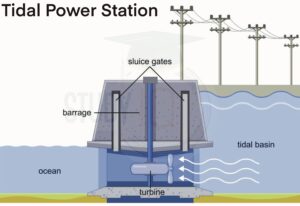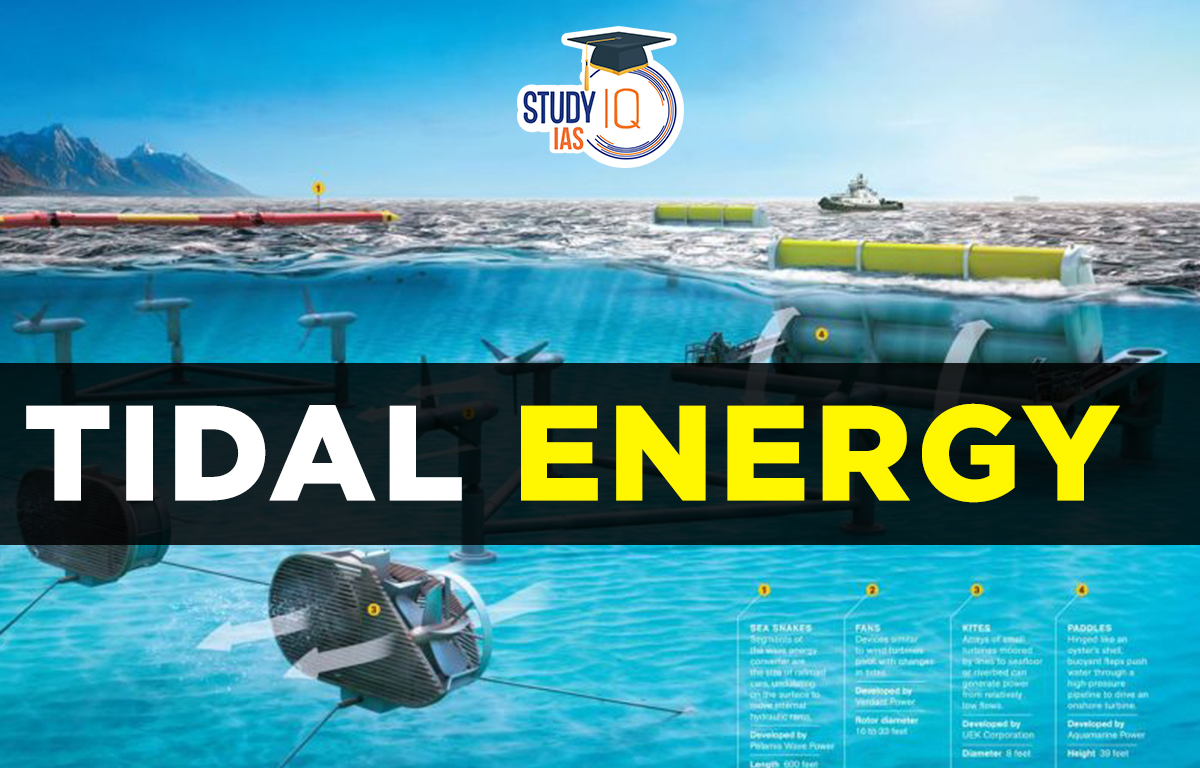Table of Contents
What is Tidal Energy?
Tidal Energy is a type of power generated by the natural rise and fall of tides caused by the gravitational interaction of the Earth, Sun, and Moon. Tidal Energy can change because of how the land is shaped, which can make tides higher. We can use special turbines in dams to turn tidal water into electricity. This works best when the tides change by more than 4 meters and when the land is right for it.
India has a lot of potential for tidal energy because it has many coastlines like in places like the Gulf of Cambay, Gulf of Kachchh, and the Ganges Delta in the Sundarbans. Dams called tidal barrages can help make power by using the water flow to spin turbines. India could make about 8000-9000 megawatts of tidal energy. Some big projects include the Kachchh Tidal Power Project in Gujarat and the Durgaduani Creek Project in West Bengal. Also, there are challenges with tidal energy. It does not provide power all the time, can be expensive to build, and there are only certain places where it can work well. It can also harm the environment by changing ecosystems and affecting wildlife. Right now, tidal energy systems aren’t very efficient and can lead to issues like flooding and hurting marine life.
Read about: Nuclear Power Plants in India
Tidal Energy Working Phenomenon
Tides are the rising and falling of water in places like bays and harbors. This movement is caused by the flow of water going in (flood) and out (ebb). Tides can be predicted months or years ahead.
The big movement of water during tides can be used to create energy. This is called tidal current or tidal stream. When water passes through narrow areas, it moves faster, creating strong tidal currents.
Tidal devices work like wind turbines but use water instead of wind to make electricity. The best places for this energy are where the tides change a lot and where the water is shallow and narrow.
Some areas known for strong tides include the La Rance estuary in France, Kisalaya Guba in Russia, the Bay of Fundy in Canada, and the Severn Estuary between England and Wales.
Read about: Major Ports in India
Tidal Energy Diagram

Read about: Hydropower Plants in India
Tidal Energy Generation Process
We can use ocean tides to make energy by building gates across inlets where the sea meets the land. When the gate is closed during high tide, it traps the incoming water. As the tide goes down outside the gate, the trapped water flows back to the sea through a pipe. This water passes through a turbine, which generates electricity.
Read about: Manganese Ore
Tidal Energy in India
Tides happen every twelve hours because of the moon’s gravity. The difference in water height between low and high tides is called potential energy. To use this tidal energy effectively, the high tide needs to be at least five meters (16 feet) higher than the low tide.
India has some of the few places in the world where tides are this high. For example, in Gujarat, the Gulf of Cambay has a maximum tidal range of 11 meters, and the Gulf of Kutch has an average tidal range of 8 meters.
Read More: Natural Gas
Tidal Energy Advantages
- Tidal energy is reliable and steady because it’s driven by gravity.
- As technology improves, tidal energy will become easier to use and more efficient.
- It helps prevent coastal flooding due to its stable design.
- Tidal lagoons can absorb storm surges and waves that happen once every 500 years.
- Tidal power equipment lasts longer and can be cheaper than other renewable energy sources.
Read about: Cobalt Ore
Government’s Initiative for Tidal Energy
The Gujarat government secured a contract in 2011 to develop a 250 MW tidal power project in the Gulf of Kutch with GPCL, Atlantis Resource Corporation (UK), and PMES, Singapore. A 50 MW tidal power project in Mandavi in the Kutch area has started its first phase. A demonstration project to construct a 3.75 MW tidal power plant at Durgaduani Creek in the Sunderbans, West Bengal, was sanctioned by the Ministry of New and Renewable Energy (MNRE) in 2008, but it was never carried out.
Read about: Minerals
Tidal Energy Challenges
Despite making quick progress with other renewable energy sources, India has not made any meaningful breakthrough in the nearly 40 years since it started attempting to evaluate and harness tidal power. A legislative panel has now asked the Indian government to reevaluate the country’s tidal power potential, look into how much of it can actually be used, carry out more research in the area, and create a tidal power pilot project.
India started building two tidal power projects in Gujarat and West Bengal in 2007 and 2011, with an installed capacity of 3.75 and 50 megawatts, respectively. However, both of these projects were put on hold because of their astronomical prices. The 3.75 MW Durgaduani tidal power project in West Bengal cost Rs. 2.38 billion to complete (Rs. 238 crore). Per megawatt of power, the 50 MW tidal power facility in Gujarat’s Gulf of Kutch was reported to have cost Rs. 7.5 billion (Rs. 750 crores).
Tidal power plants haven’t been established in India for a number of reasons, including prohibitive costs and environmental risks. Tidal power is not being pursued globally either due to a number of barriers.
Read More: Types of Rocks
Tidal Energy Disadvantages
- Building tidal power plants is expensive due to high initial costs.
- Environmental issues include fish getting hit by turbine blades, noise from turbines, changes in sediment, and habitat changes.
- These effects are specific and do not impact the whole estuary or bay.
- Repairing and maintaining equipment can be difficult.
- Tidal energy is only available for about 10 hours a day, so storage is needed.
- It is hard to provide tidal energy to inland areas because the energy is generated far from where it’s used.
Read More: Wave Energy
Tidal Energy UPSC
The gravitational interaction between the Earth, the sun, and the moon, which results in the tides’ normal rise and fall, produces a particular kind of energy known as tidal energy. Tidal currents with enough energy to be harvested emerge when water moves more quickly past a restriction. Estimates from the Indian government place the nation’s tidal energy potential at 8,000 MW. This includes around 7,000 MW in the Gulf of Cambay in Gujarat, 1,200 MW in the Gulf of Kutch in Gujarat, and 100 MW in the Gangetic delta of the Sunderbans in West Bengal. Tidal energy is produced when the ocean waters rise and fall with the tides. A renewable energy source is tidal power. You will learn about Tidal Energy in India from this article, which will help you with your geography study for the UPSC/IAS exam.


 El Nino and La Nina and its Impact on In...
El Nino and La Nina and its Impact on In...
 Manganese Ore, Uses, Properties, Importa...
Manganese Ore, Uses, Properties, Importa...
 Faraizi Movement, History, Founder, Begi...
Faraizi Movement, History, Founder, Begi...




















